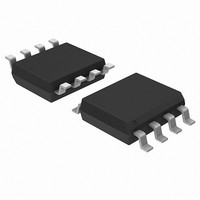MCP79410-I/MS Microchip Technology, MCP79410-I/MS Datasheet - Page 7

MCP79410-I/MS
Manufacturer Part Number
MCP79410-I/MS
Description
IC RTC/CALENDER 8MSOP
Manufacturer
Microchip Technology
Type
Clock/Calendar/EEPROMr
Datasheet
1.MCP79410T-IMNY.pdf
(34 pages)
Specifications of MCP79410-I/MS
Package / Case
8-TSSOP, 8-MSOP (0.118", 3.00mm Width)
Time Format
HH:MM:SS (12/24 hr)
Date Format
YY-MM-DD-dd
Memory Size
1K (128 x 8)
Interface
I²C, 2-Wire Serial
Voltage - Supply
1.8 V ~ 5.5 V
Operating Temperature
-40°C ~ 85°C
Mounting Type
Surface Mount
Function
Clock/Calendar
Rtc Memory Size
64 B
Supply Voltage (max)
5.5 V
Supply Voltage (min)
1.8 V
Maximum Operating Temperature
+ 85 C
Minimum Operating Temperature
- 40 C
Mounting Style
SMD/SMT
Rtc Bus Interface
I2C
Supply Current
400 uA
Clock Format
HH
Clock Ic Type
RTC
Ic Interface Type
I2C
Memory Configuration
128 X 8
Supply Voltage Range
1.8V To 5.5V
Digital Ic Case Style
MSOP
Rohs Compliant
Yes
Lead Free Status / RoHS Status
Lead free / RoHS Compliant
Lead Free Status / RoHS Status
Lead free / RoHS Compliant, Lead free / RoHS Compliant
Available stocks
Company
Part Number
Manufacturer
Quantity
Price
Part Number:
MCP79410-I/MS
Manufacturer:
MICROCHI
Quantity:
20 000
3.0
3.1
The MCP7941X supports a bidirectional 2-wire bus and
data transmission protocol. A device that sends data
onto the bus is defined as transmitter, and a device
receiving data as receiver. The bus has to be controlled
by a master device which generates the Start and Stop
conditions, while the MCP7941X works as slave. Both
master and slave can operate as transmitter or receiver
but the master device determines which mode is
activated.
3.1.1
The following bus protocol has been defined:
• Data transfer may be initiated only when the bus
• During data transfer, the data line must remain
Accordingly, the following bus conditions have been
defined
3.1.1.1
Both data and clock lines remain high.
3.1.1.2
A high-to-low transition of the SDA line while the clock
(SCL) is high determines a Start condition. All
commands must be preceded by a Start condition.
3.1.1.3
A low-to-high transition of the SDA line while the clock
(SCL) is high determines a Stop condition. All
operations must end with a Stop condition.
FIGURE 3-1:
2010 Microchip Technology Inc.
is not busy.
stable whenever the clock line is high. Changes in
the data line while the clock line is high will be
interpreted as a Start or Stop condition.
SCL
SDA
(Figure
(A)
I
I
BUS CHARACTERISTICS
2
2
C Interface
C™ BUS CHARACTERISTICS
Bus not Busy (A)
Start Data Transfer (B)
Stop Data Transfer (C)
Condition
Start
(B)
3-1).
DATA TRANSFER SEQUENCE ON THE SERIAL BUS
Acknowledge
Address or
Valid
(D)
Preliminary
to Change
Allowed
Data
3.1.1.4
The state of the data line represents valid data when,
after a Start condition, the data line is stable for the
duration of the high period of the clock signal.
The data on the line must be changed during the low
period of the clock signal. There is one bit of data per
clock pulse.
Each data transfer is initiated with a Start condition and
terminated with a Stop condition. The number of the
data bytes transferred between the Start and Stop
conditions is determined by the master device.
3.1.1.5
Each receiving device, when addressed, is obliged to
generate an Acknowledge signal after the reception of
each byte. The master device must generate an extra
clock pulse which is associated with this Acknowledge
bit.
A device that acknowledges must pull down the SDA
line during the Acknowledge clock pulse in such a way
that the SDA line is stable-low during the high period of
the Acknowledge-related clock pulse. Of course, setup
and hold times must be taken into account. During
reads, a master must signal an end of data to the slave
by NOT generating an Acknowledge bit on the last byte
that has been clocked out of the slave. In this case, the
slave (MCP7941X) will leave the data line high to
enable the master to generate the Stop condition.
Note: The MCP7941X does not generate any
Data Valid (D)
Acknowledge
EEPROM Acknowledge bits if an internal
programming cycle is in progress. The
user may still access the SRAM and RTCC
registers during an EEPORM write.
(D)
MCP7941X
DS22266A-page 7
Condition
Stop
(C)
(A)















